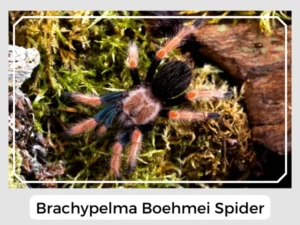Brachypelma is a fascinating group of spiders from the Tarantula family. They’re mostly found in places like Mexico and Central America. As of October 2017, there are 17 types of these spiders. Some have red legs, and others have a red rump. Get ready to explore fun facts about them!

The eggs of most of the species are round in the size of a golf ball. They mostly hatch before the rainy season commences.
In the initial months of their life, the spiderlings molt in two weeks.
Like most members of the tarantula family, these spiders do not spin webs but capture their prey through hunting.
Yes, Brachypelma tarantulas have venom. But for humans, it’s usually not very strong. They mostly use it to help catch their food.
Brachypelma tarantulas can bite if they’re disturbed. The bite might cause a little discomfort and skin allergies, but it’s generally not very serious for most people.
Brachypelma tarantulas play a significant role in their ecosystems, serving as both predators and prey. Their hunting habits help control the populations of various smaller animals and insects, maintaining ecological balance. They exhibit solitary and territorial behavior, often residing in burrows or under rocks.
Natural Predators: Despite their venomous capabilities, Brachypelma tarantulas are not without threats. They fall prey to snakes, lizards, large birds, and wasps, showcasing the complex predator-prey dynamics in their habitats.
Prey-Predator Dynamics: In their environment, these tarantulas contribute to controlling the populations of their prey, while also providing food for their predators. This balance is crucial for the stability of their ecosystems.
Relationship with Humans: The pet trade has played a significant role in the relationship between Brachypelma tarantulas and humans. Their popularity as pets has led to increased awareness of their species, though it has also contributed to challenges in their conservation. Ensuring their survival necessitates responsible pet ownership and concerted conservation efforts to protect their natural habitats.
| Lifespan | Males: 4-5 years Females: 10 years |
| Distribution | Throughout Mexico and Central America |
| Habitat | Thorny forests, deciduous forests, scrublands, deserts |
| Predators | Snakes, lizards, large birds, and wasps |
| Diet | Rodents, insects, small frogs, and other spiders |
In conclusion, the Brachypelma genus encapsulates the diversity and allure of tarantulas, offering a glimpse into the intricate web of life they are a part of.
Brachypelma is a fascinating group of spiders from the Tarantula family. They’re mostly found in places like Mexico and Central America. As of October 2017, there are 17 types of these spiders. Some have red legs, and others have a red rump. Get ready to explore fun facts about them!

The eggs of most of the species are round in the size of a golf ball. They mostly hatch before the rainy season commences.
In the initial months of their life, the spiderlings molt in two weeks.
Like most members of the tarantula family, these spiders do not spin webs but capture their prey through hunting.
Yes, Brachypelma tarantulas have venom. But for humans, it’s usually not very strong. They mostly use it to help catch their food.
Brachypelma tarantulas can bite if they’re disturbed. The bite might cause a little discomfort and skin allergies, but it’s generally not very serious for most people.
Brachypelma tarantulas play a significant role in their ecosystems, serving as both predators and prey. Their hunting habits help control the populations of various smaller animals and insects, maintaining ecological balance. They exhibit solitary and territorial behavior, often residing in burrows or under rocks.
Natural Predators: Despite their venomous capabilities, Brachypelma tarantulas are not without threats. They fall prey to snakes, lizards, large birds, and wasps, showcasing the complex predator-prey dynamics in their habitats.
Prey-Predator Dynamics: In their environment, these tarantulas contribute to controlling the populations of their prey, while also providing food for their predators. This balance is crucial for the stability of their ecosystems.
Relationship with Humans: The pet trade has played a significant role in the relationship between Brachypelma tarantulas and humans. Their popularity as pets has led to increased awareness of their species, though it has also contributed to challenges in their conservation. Ensuring their survival necessitates responsible pet ownership and concerted conservation efforts to protect their natural habitats.
| Lifespan | Males: 4-5 years Females: 10 years |
| Distribution | Throughout Mexico and Central America |
| Habitat | Thorny forests, deciduous forests, scrublands, deserts |
| Predators | Snakes, lizards, large birds, and wasps |
| Diet | Rodents, insects, small frogs, and other spiders |
In conclusion, the Brachypelma genus encapsulates the diversity and allure of tarantulas, offering a glimpse into the intricate web of life they are a part of.